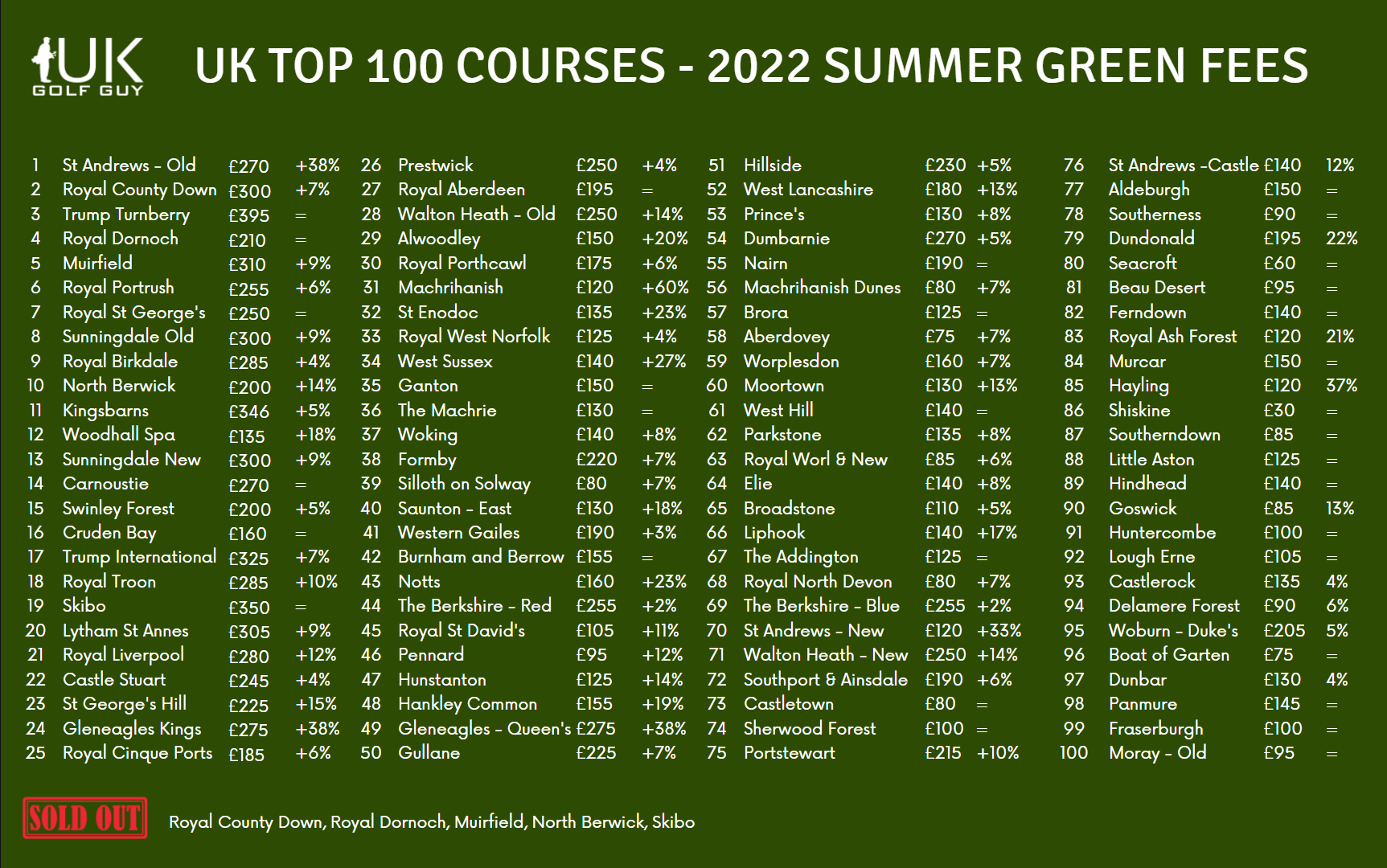It’s proving difficult to play the top British golf courses in 2022. The combination of carried over reservations from previous years and pent up demand means that courses up and down the country are full to the brim. And not only will it be hard to get a tee time, golfers will also be paying more than ever before.
I have analysed the green fees at the top 100 courses in the UK and it makes for sobering reading with golfers facing record price increases.
However, before we get on to that, a note on methodology. I have used the latest Golf World Top 100 list and considered the UK courses where it is possible for a member of the public to get a tee time. I have then looked at the peak summer rate (normally the weekend rate). Of course there will be deals at some courses for twilight times and the like but this seemed the best way to comapre courses across the board.
I have written before about winter rates and courses under £70 so if you are looking for one of those deals please do read those articles.
This research was carried out over a couple of weeks so some rates may have changed (and there is always the risk of fat typing fingers) but here are the peak summer green fees, and the changes from last year.
Some headline figures from the analysis…
The average green fee rose up by 8% this year from £161 to £174.
68 out of the 100 courses increased their prices.
The average rate for a top 25 course is now £266.
And some of the key things I took away from the research…
THERE’S A RADICAL NEW APPROACH FROM ST ANDREWS - AND IT’S NOT GOOD NEWS!
In 2000 it cost £80 to play 18 holes over the Old Course at peak time. Since then, pretty much every year, it has gone up by £5 or £10, so that by 2021 it was £195 for a round. This increase was ahead of the cost of living (if it had tracked inflation it would have been £145 in 2021) but still didn’t seem unreasonable to play such a magnificent place.
When the increase for 2022 was initially published online by the Links Trust last autumn, it appeared to be in line with this trend, nudging just over the £200 mark. But then that page mysteriously disappeared, and was replaced with the news that the Old Course green fees had been revised up to £270 a round.
And it isn’t just the Old Course that has seen such an increase. The New and Jubilee courses have both gone from £90 to £120 too.
Green fees are set at the Links Trust. In their 2020 accounts they itemised the loss of income from both green fee play and merchandising and it was clearly significant. They managed costs well and were beneficiaries of the government’s Covid funding scheme.
However, it appears this wasn’t enough. The 2021 accounts won’t come out for another couple of months but it will be interesting to see why they believe such drastic action was necessary.
I reached out to the Links Trust to discuss this, but unfortunately they weren’t forthcoming. They appointed a new Chief Executive around the time the original green fees were removed from the website and my key question was going to be whether there is a strategic plan for green fees for the future?
This 38% green fee increase should fill the revenue hole from Covid within a couple of years, but will the fees then reduce to their previous levels? If history tells us anything, the answer will be no.
It would be a shame if green fees stay at these new levels and the excess revenue is ‘reinvested’ in slicker shops, fancier restaurants and further lengthening of the course.
If they take this route, no doubt the Links Trust will tell us they are ‘enhancing the consumer experience’ to meet the needs of their ‘increasing demanding clientele’. Meanwhile, average golfers will find themselves priced out of the only consumer experience that truly matters here - playing this majestic course.
Peter Thomson, the Australian golfer who won the Open an incredible 5 times, once said that no golf course should charge more than St Andrews. Well if the Links Trust continue on this trajectory, that won’t be a problem.
THERE’S A SHIFT IN THE BALANCE OF POWER AT THE TOP CLUBS
Many of the top courses simply don’t want any more bookings this year. They are full. Well, kind of. These clubs have set bookings revenue targets for the year and now those have been achieved they will take no more bookings. Of course, the higher the green fees are set, the fewer bookings are needed to hit the target.
This also plays well with the membership at most clubs. Many members of these top clubs want to minimise visitor play so they can have access to a wider range of tee times. Balancing accessibility and keeping their subs down is the game that all club secretaries and GMs wrestle with.
When you combine this with the fact that some bookings are still carrying over from 2020 and 2021, the reality is that several of the top courses simply can’t accommodate you this year. Muirfield, Royal County Down, Royal Dornoch and North Berwick have all closed their books for this year. This is part of the reason that increases in green fees will continue to come at these top courses. Frankly, some could put the rates up 50% and they would still sell out.
Interestingly, if you look more closely at the increases, you can see that 40 of the top 50 have put their rates up, compared with just 28 of those in places 51-100. Most of them will have better visitor availability this year as they have fewer ‘carried over’ bookings. Many also put through big price increases last year.
Royal County Down is full for 2022
SOME SCOTTISH COURSES CONTINUE TO LOOK AFTER THEIR OWN
It all started with Kingsbarns. When they opened over 20 years ago they had a discounted rate for Scottish golfers booking a couple of weeks ahead of time, if there were tee times available. At the time that was seen as quite a nice gesture of goodwill to the locals from a course targeted very clearly at American golfers.
Fast forward a couple of decades and several courses now have twin-track pricing. They have one rate for Scots, or sometimes Brits, and one for the rest of the world. This tactic could be seen as a cynical attempt to price gouge foreigners. I highlighted last year how Brora were charging £90 for British golfers and £125 for foreigners. Little Britain was alive and well.
This year others have joined the game. Machrihanish has whacked up its prices for foreigners. It was £75 a person last year; this year it’s an amazing £120. If you’re a member of a Scottish golf club that’s discounted to £90 but, if you’re just a Scottish person on holiday in the area wanting to play golf, and not a member of a club, you’ll pay the full £120.
Some courses which used to be considered gems are now at risk of being considered greedy and the visitor experience will only be diminished.
FOR ‘VALUE’ YOU NEED TO BE PREPARED TO TRAVEL
There are 13 courses where you can play eighteen holes at the weekend for under £100 - Silloth, Pennard, Machrihanish Dunes, Aberdovey, Castetlown, Southerness, Sea Croft, Beau Desert, Shiskine, Southerndown, Goswick, Boat of Garten and Moray.
This is a wonderful collection of courses for sure, however if you were to make a list of the most remote courses, most of them would feature on that too! Their lower green fees are, at least in part, a function of the difficulty getting to them.
Of course, if you make the effort to get to these places you will often find a wonderful value trip if you include their neighbouring courses. They will be lesser known names, but far more likely to give you great value.
Gorgeous Pennard - one of the cheaper tee times on the list
THE ONLY WAY IS UP
I hate to say it but I don’t hold out great hope that this inexorable and aggressive rise in green fees will halt any time soon. Golf clubs have become really busy places. Members are playing more and more which means the pressure on tee times is greater than ever before. If you are a top club then driving revenue through fewer, but higher green fees would appear to be a winning combination. Combine that with the return of the international golf traveller and I think these high levels of inflation of here to stay.
This week, Muirfield released its tee times for 2023. Every single summer time sold out within a couple of hours. That would have been unthinkable just three years ago.
I know that some people will say that I should count myself lucky to be able to play these courses at all and to stop moaning and whinging. To a small extent I agree with that view, but the reality is that, as a result of this changing dynamic, many golfers will now never play some of the greatest courses on these shores.
However, I think there is a silver lining. Maybe as a result of all this we will get a little less obsessed with chasing the top courses and golfers may well end up discovering new, less heralded courses, finding more of the other wonderful places to tee it up this country has on offer.




